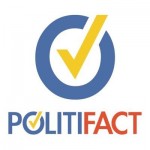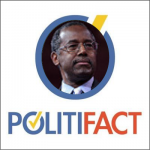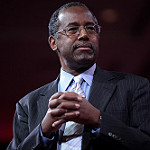 “[Becky] Quick’s math is sound, based on what’s publicly known about Carson’s plan. Carson’s 15 percent flat tax would generate a $1.1 trillion hole. By his own math, his plan would create a $1 trillion hole.”
“[Becky] Quick’s math is sound, based on what’s publicly known about Carson’s plan. Carson’s 15 percent flat tax would generate a $1.1 trillion hole. By his own math, his plan would create a $1 trillion hole.”
—PolitiFact, from a Nov. 4, 2015 fact check of GOP presidential contender Ben Carson
Overview
PolitiFact’s omissions and misrepresentations leave behind a misleading impression of the effects of Ben Carson’s tax proposal.
The Facts
On Oct. 29, 2015, CNBC hosted a debate among the GOP presidential hopefuls, including candidate and former neurosurgeon Ben Carson. One of CNBC’s three moderators, Becky Quick, questioned Carson over his tax reform proposal:
BECKY: Dr. Carson, let’s talk about taxes. You have a flat tax plan of 10 percent flat taxes. And I’ve looked at it, and this is something that is very appealing to a lot of voters, but I’ve had a really tough time trying to make the math work on this.
If you were to take a 10 percent tax with the numbers right now on total personal income, you’re going to come in with bringing in $1-1/2 trillion. That is less than half of what we billed bringing in right now.
And, by the way, it’s going to leave us in a $2 trillion hole. So what analysis got you to the point where you think this will work?
CARSON: Well, first of all, I didn’t say that the rate would be 10 percent. I used the tithing analogy.
BECKY: I understand, but if you look at the numbers, you probably have to get to 28 —
CARSON: The rate is going to be much closer to 15 percent.
BECKY: 15 percent still leaves you with a $1.1 trillion hole.
CARSON: Let me finish. You also have to get rid of all the deductions and all the loopholes. You also have to do some strategic cutting in several places.
Remember, we have 645 federal agencies and subagencies. Anybody who tells me that we need every penny in every one of those is in a fantasy world.
So, also, we can stimulate the economy. That’s going to be the real growth engine, stimulating the economy, because it’s tethered down right now with so many regulations.
BECKY: You would have to cut government by about 40 percent to make it work with a $1.1 trillion hole.
CARSON: It’s not true.
BECKY: It is true. I looked at the numbers.
CARSON: When we put all the facts down, you will be able to see that it’s not true. It works out very well.
BECKY: Dr. Carson, thank you.
Mainstream fact checker PolitiFact examined Carson’s contradiction of Quick’s claim his plan would leave a $1.1 trillion hole in the federal budget. PolitiFact found “False” Carson’s claim that his plan would not leave a $1.1 trillion hole. Moreover, PolitiFact judged that Quick’s math was sound.
Was Quick’s math sound? Is PolitiFact right that Carson’s own math shows his plan would create a $1 trillion hole in the budget?
Analyzing the Rhetoric
We’ll review what is known of Carson’s tax reform plan and then analyze PolitiFact’s treatment of the plan’s effects.
Carson’s Tax Reform Plan
We found three notable problems with PolitiFact’s analysis of Carson’s math. First, PolitiFact ignored Carson’s stipulation that spending cuts would help address the deficit. Second, PolitiFact ignored federal receipts not from income or payroll taxes. Third, PolitiFact ignored how Carson’s plan relies partly on economic expansion to balance receipts with spending.
PolitiFact mentions these aspects of Carson’s plan but omits them from the math used to calculate the deficit.
PolitiFact summarized Carson’s plan by emphasizing four parts of it. PolitiFact said his plan would establish a flat tax of 10-15 percent with no deductions, create a six-month hiatus for corporate profits earned in foreign markets, tax corporate income at a 15-20 percent rate and end the payroll tax.
Calculating the Budget Effects
PolitiFact used Becky Quick’s math as its standard:
Quick likely got her numbers by applying Carson’s 15 percent tax rate to the total personal income and the total corporate income ($15.4 trillion and $2.1 trillion respectively, by the latest Bureau of Economic Analysis estimates for 2015). That would generate about $2.6 trillion in revenue.
So Carson’s plan falls $0.6 trillion short of anticipated revenue, and $1.1 trillion short of spending. To break even, you’d have to reduce spending by about 30 percent annually, not as Quick said, 40 percent.
Note that Quick and PolitiFact compare Carson’s plan to an imaginary baseline scenario that balances the budget in a single year. Note also that federal receipts from excise taxes do not appear in the calculations. Federal excise taxes and fees, including the estate tax, made up almost 10 percent of federal revenue in 2014. If Carson’s tax plan eliminates excise taxes then PolitiFact should mention it to justify leaving out that income. We found no evidence that Carson’s plan gets rid of federal excise taxes, though it does end the estate tax. But the estate tax accounted for less than 1 percent of federal revenue in 2014.
A Congressional Budget Office projection PolitiFact cited gives an estimate of $0.28 trillion for non-income tax revenues (Table 4-1, Page 95) in 2015, after subtracting projected income from the estate tax ($20 billion). Subtracting that $0.28 trillion from Quick’s $0.6 trillion leaves a $0.32 trillion shortfall.
PolitiFact and Quick exaggerate the shortfall under Carson’s plan by about 85 percent. That’s with no consideration of spending cuts or a revenue boost from economic stimulus.
Measuring Carson’s plan against the imaginary balanced budget scenario, PolitiFact and Quick exaggerate the deficit hole by 34 percent, and Carson’s plan would carry responsibility for only $0.32 trillion of that hole, not the $1.1 trillion trumpeted in PolitiFact’s headlines. PolitiFact and Quick should have used was the $0.5 trillion deficit figure as the baseline for comparison. Carson’s plan would increase that deficit from $0.5 trillion to $0.82 trillion, though budget cuts and economic stimulus could bring that figure lower.
See the table below.
| Income taxes | excise taxes, other | Budget cuts | Economic growth | Deficit overall | Deficit from baseline | |
|---|---|---|---|---|---|---|
| Quick | $2.6 | 0 | 0 | 0 | -$1.1 | -$0.6 |
| ZFC estimate | $2.6 | $0.28 | ? | ? | -$0.82 | -$0.32 |
The Unmentioned Balanced Budget Amendment
One may justify emphasizing the gap between revenue and spending under Carson’s plan by pointing to Carson’s support of a balanced budget amendment. Neither Quick nor PolitiFact mentioned Carson’s support for such an amendment.
If one assumes Carson must achieve a balanced budget in 2015 based on federal income estimates, then Carson would need to cut government spending by less than 25 percent. That’s below PolitiFact’s estimate of 30 percent and much less than Quick’s estimate of 40 percent.
Given Carson’s support of balanced budget amendment it makes sense to estimate the difference between revenue and spending and ask Carson how he would deal with the discrepancy. In fairness to Carson, though, that line of questioning ought to emphasize his support for a balanced budget amendment. Taking that line of questioning while omitting that important context will tend to mislead the audience.
Estimated revenue should not exclude revenue sources like federal excise taxes unless Carson proposes ending those taxes.
Summary
“[Becky] Quick’s math is sound, based on what’s publicly known about Carson’s plan.”
Quick assumed, without any apparent justification, that Carson’s tax plan would exclude federal revenue sources not mentioned in Carson’s plans, such as federal excise taxes. Quick’s math may be sound, but leaving out such revenues renders Quick’s math and equations misleading. Quick’s equations make unjustified assumptions about Carson’s plan. It follows that PolitiFact’s claim that Quick’s math is based on what is publicly known about Carson’s plan is false.
“Carson’s 15 percent flat tax would generate a $1.1 trillion hole.”
Given that $0.5 trillion of the hole occurs in the current budget estimate for 2015, it is unfair to say Carson’s tax would “generate” that hole. PolitiFact left out some sources of federal revenue. Adding the impact of federal income raised outside the income tax system cuts the deficit PolitiFact projects for Carson’s plan. That plan would increase the baseline deficit by an estimated $0.39 trillion, not counting budget cuts or increased economic activity. It would not “generate a $1.1 trillion hole” unless Carson somehow receives blame for the deficit as projected without his tax plan.
“By his own math, his plan would create a $1 trillion hole.”
Carson did not present a complete calculation of his tax plan. PolitiFact took Carson’s estimate of what an 15 percent income tax might raise and took it as a completed estimate. Given the context, PolitiFact’s interpretation proves untenable. Carson talked about making budget cuts to help address the difference. PolitiFact left that out and called the rest of Carson’s reasoning “his own math.”
When Carson’s tax plan is combined with his support for a balanced budget amendment he appears to leave an unexplained deficit. But saying Carson’s tax plan by itself creates a $1 trillion deficit builds a false picture of Carson’s proposal.
Notes:
We contacted writer/researcher Linda Qiu and editor Angie Drobnic Holan of PolitiFact about the discrepancies we found in PolitiFact’s fact check. We will update this item if we receive any response.
A Quick Note on Quick
CNBC’s Becky Quick explained to Carson that she understood he was proposing a flat tax in the neighborhood of 15 percent. She had at her fingertips revenue estimates based on that tax rate. Yet her questioning of Carson led with the assumption that he would fix his flat tax at 10 percent.
Why?
References
“CNBC Full Transcript: CNBC’s “Your Money, Your Vote: The Republican Presidential Debate” (Part 2).” CNBC.com. CNBC LLC, 29 Oct. 2015. Web. 11 Nov. 2015.
Qiu, Linda. “Does Ben Carson’s Tithe-based Tax Plan Lead to a $1 Trillion Hole?” PolitiFact.com. Tampa Bay Times, 04 Nov. 2015. Web. 11 Nov. 2015.
“Policy Basics: Where Do Federal Tax Revenues Come From?” Center on Budget and Policy Priorities. Center on Budget and Policy Priorities, 11 Mar. 2015. Web. 11 Nov. 2015.
“The Budget and Economic Outlook: 2015 to 2025.” CBO.gov. Congressional Budget Office, Jan. 2015. Web. 11 Nov. 2015.
“Balanced Budget Amendment.” Bencarson.com. Carson America, Inc., 2015. Web. 11 Nov. 2015.
Carson, Ben. “Full Interview: Dr. Ben Carson on the Economy.” Interview by Kai Ryssdal. Marketplace.org. American Public Media, 07 Oct. 2015. Web. 11 Nov. 2015.






